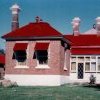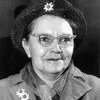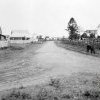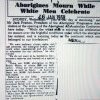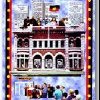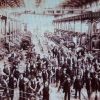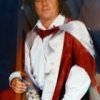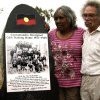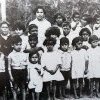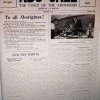1920s
1920
In the Central Police Court, Agnes Jones is sentenced to 14 days, ‘Unlawful assault’, and 1 month and three days, concurrent, ‘Indecent Language’ and ‘Drunk’.
1921
1922
1923
1924
The Australian Association for the Protection of Aborigines is founded, wanting to restore land to Koori people, to prevent the increasing removal of Koori children from their families, and to abolish the Aborigines Protection Board. This follows a more active role of Board officers and police in child removal (see entries for 1917, 1920, 1923). They form an alliance with a sympathetic white woman, Elizabeth McKenzie-Hatton, also known as "Mrs Mac" amongst the local Kooris. The group buys a house in Homebush as a hostel for Aboriginal girls who are ‘incorrigible’ that is, those who have run away or defied their employers. (Maynard 2008, pp. 44-5)
Kinchela Boys Home is established by the Aboriginal Protection Board. The Home is intended for Aboriginal boys removed from their families as part of the process of 'assimiliation'. The victims of this process eventually became known as the Stolen Generation. The Home houses between 40 and 60 boys until it is closed in 1970. Justice Hal Wootten’s Reports, for the Aboriginal Deaths in Custody Royal Commission, document the brutal punishment and sexual abuse suffered by these boys in the Kinchela Home, or later.
Following strong criticism from the Association for the Protection of Aborigines, a Sydney newspaper accuse the Aborigines Protection Board of hastening the disappearance of the Aboriginal girls by isolating them in the city. The argument is that girls are unlikely to meet Aboriginal men and – it being apparently unthinkable that they should marry white men – the result will be necessarily fewer Koori people.
1925
Alfred James White, an ex-serviceman, writes from 9 Pitt Street, Redfern in 1925: ‘Dear Sir, I now take the advantage of writing to you asking you could you oblige me by giving me some information concerning the canteen funds, how they’ve run out. Also … could you tell me if a soldier had any money stocked on the other side, could he draw that money here? And I would like you to help me if you could as I am in a very bad way just now. I have never had a penny from the military since I came home. So trusting you will try and help me for a quick return; so trusting you will oblige me. I am yours faithfully, AJ White, #2710, 7th Bn., Australian Light Horse.’ (Scarlett, p. 32)
The Australian Aboriginal Progressive Association holds its first conference at St David’s Hall, Surry Hills. The newspapers report their aim as: ‘ON ABORIGINES’ ASPIRATIONS – FIRST AUSTRALIANS TO HELP THEMSELVES – SELF DETERMINATION,’ and ‘ABORIGINES IN CONFERENCE – SELF DETERMINATION IS THEIR AIM – TO HELP A PEOPLE.’ Its chief spokesman is Fred Maynard, a Hunter River Koori. Its letterhead carries the motto ‘One God, one Aim, one Destiny.’ In the early months, Fred Maynard and Elizabeth Mackenzie Hatton make a number of trips up and down the coast inspecting Koori living conditions, particularly on the reserves. (Maynard 2008, p. 53, Goodall, p. 152)
Elsa Dixon born 1925. She goes on to live in Campbell St, Darlinghurst for 32 years and helps create many services for Aboriginal people.
1926
1927
The AAPA program demands land as an economic base and compensation for dispossession. Fred Maynard, spokesman for the Association, writes to the Premier, ‘I wish to make it perfectly clear, on behalf of our people, that we accept no condition of inferiority as compared with European people. Two distinct civilisations are represented by their respective races… that the European people by the arts of war destroyed our more ancient civilisation is freely admitted, and that by their vices and diseases our people have also been decimated is also patent, but neither of these facts are evidence of superiority.’ (Goodall, pp. 163-4).
Fred Maynard leader of the AAPA, writes to a young Koori girl abused within the Aboriginal apprenticeship system: ‘My heart is filled with regret and disgust. First that you were taken down by those who were supposed to be your help and guide through life. What a wicked conception, what a fallacy. Under the so-called pretence and administration of the Board, government controlled etc. I say deliberately, the whole damnable thing has got to stop and by God's help it shall, make no mistake. No doubt, they are trying to exterminate the Noble and Ancient Race of southern Australia. Away with their damnable insulting methods’. Maynard 2008, p. 1.
Fred Maynard’s son Merv recalls how as a young boy, he is picked up along with another young Aboriginal boy and terrorised by the police at Canterbury police station: ‘I never realised at the time, only being a bit of a kid, I didn’t tell Mum or Dad for fear of getting into further trouble, but in retrospect the whole episode had been about getting the point across to my father, that they could pick up and take us kids anytime they liked. Naturally they had expected me to relate the details to my father but I had just clammed up’. (Maynard 2008 p. 132)
1928
As white women begin to leave domestic service to work in factories, their places are taken by Koori girls, often sent at 12 or 13 years of age, from the Cootamundra Home. There is factory work available for older Koori women growing up in Sydney, such as Lever Brothers, Colgate, Palmolive and Pearson’s Soap, but most girls and young women are sent to become housemaids and childminders.
According to John Maynard, Fred Maynard’s biographer, the most unsettling aspect of the AAPA to the Protection Board, is the fact that it is led by a self-educated and well-educated Aboriginal man with a great command of both the spoken and written word. ‘Maynard 1988 spoke and wrote passionately and insightfully about the injustices and atrocities committed against Aboriginal people. He spoke of things that many white people did not know or were not aware of, or simply did not want to know.’(Maynard 1988, p. 7)












